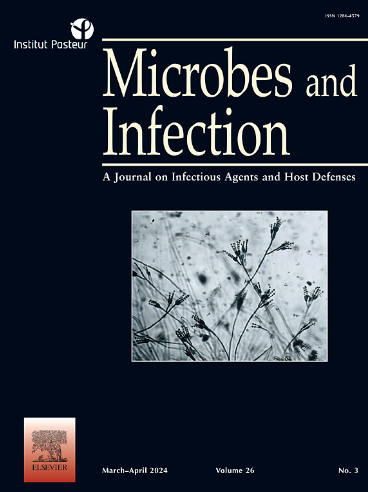人畜共患链球菌脑膜炎涉及的细菌和宿主因素
IF 2.7
4区 医学
Q3 IMMUNOLOGY
引用次数: 0
摘要
人畜共患病链球菌可引起多种侵袭性疾病,死亡率很高,尤其是脑膜炎。许多研究阐明了人畜共患链球菌脑膜炎的发病机制,其中一些研究针对某些细菌种类。与此相反,另一些则是不同细菌种类共有的,包括定植和侵入粘膜屏障、在血液中存活、突破血脑和/或血脑脊液屏障进入中枢神经系统,以及引发脑膜炎症。本综述重点介绍了最近在理解导致人类或动物脑膜炎的五种主要人畜共患链球菌(包括、亚种、、和)的分子和细胞事件方面取得的进展。其基本机制归纳为四个主题,包括:1)细菌在血液中存活;2)脑微血管内皮细胞粘附和入侵;3)穿透血脑屏障;4)激活免疫系统和脑内炎症反应。本综述可能有助于开发预防或减轻链球菌脑膜炎损伤的疗法,并改善风险分层。本文章由计算机程序翻译,如有差异,请以英文原文为准。
Bacterial and host factors involved in zoonotic Streptococcal meningitis
Zoonotic streptococci cause several invasive diseases with high mortality rates, especially meningitis. Numerous studies elucidated the meningitis pathogenesis of zoonotic streptococci, some specific to certain bacterial species. In contrast, others are shared among different bacterial species, involving colonization and invasion of mucosal barriers, survival in the bloodstream, breaching the blood–brain and/or blood–cerebrospinal fluid barrier to access the central nervous system, and triggering inflammation of the meninges. This review focuses on the recent advancements in comprehending the molecular and cellular events of five major zoonotic streptococci responsible for causing meningitis in humans or animals, including Streptococcus agalactiae, Streptococcus equi subspecies zooepidemicus, Streptococcus suis, Streptococcus dysgalactiae, and Streptococcus iniae. The underlying mechanism was summarized into four themes, including 1) bacterial survival in blood, 2) brain microvascular endothelial cell adhesion and invasion, 3) penetration of the blood–brain barrier, and 4) activation of the immune system and inflammatory reaction within the brain. This review may contribute to developing therapeutics to prevent or mitigate injury of streptococcal meningitis and improve risk stratification.
求助全文
通过发布文献求助,成功后即可免费获取论文全文。
去求助
来源期刊

Microbes and Infection
医学-病毒学
CiteScore
12.60
自引率
1.70%
发文量
90
审稿时长
40 days
期刊介绍:
Microbes and Infection publishes 10 peer-reviewed issues per year in all fields of infection and immunity, covering the different levels of host-microbe interactions, and in particular:
the molecular biology and cell biology of the crosstalk between hosts (human and model organisms) and microbes (viruses, bacteria, parasites and fungi), including molecular virulence and evasion mechanisms.
the immune response to infection, including pathogenesis and host susceptibility.
emerging human infectious diseases.
systems immunology.
molecular epidemiology/genetics of host pathogen interactions.
microbiota and host "interactions".
vaccine development, including novel strategies and adjuvants.
Clinical studies, accounts of clinical trials and biomarker studies in infectious diseases are within the scope of the journal.
Microbes and Infection publishes articles on human pathogens or pathogens of model systems. However, articles on other microbes can be published if they contribute to our understanding of basic mechanisms of host-pathogen interactions. Purely descriptive and preliminary studies are discouraged.
 求助内容:
求助内容: 应助结果提醒方式:
应助结果提醒方式:


